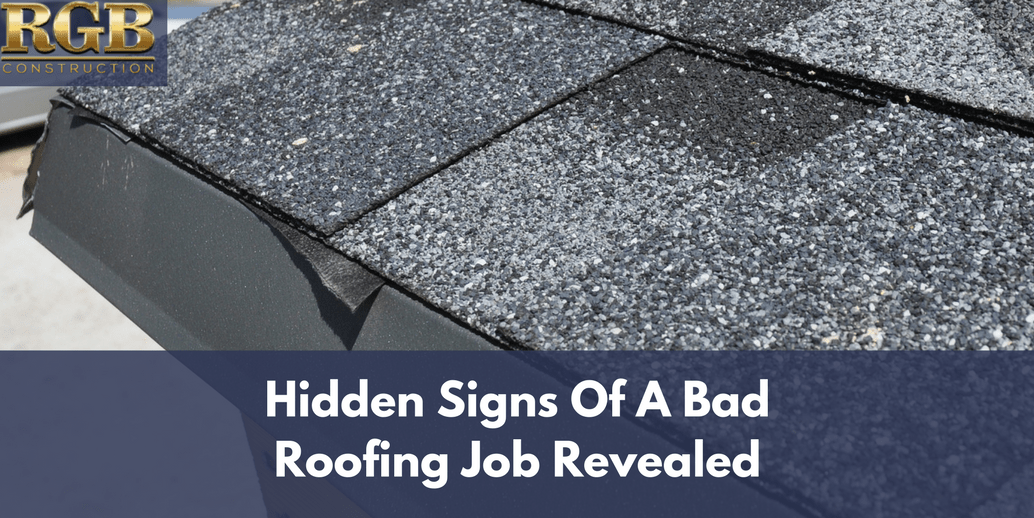There is nothing more exasperating and costly than realizing that your roof has been poorly built, repaired or replaced because of faulty and poor workmanship. All sorts of problems can occur when a roof has been improperly prepared and installed. Not only can future leaks be a result of such inefficiency, but other problems can arise and create ongoing and never-ending roof projects.
In spite of the problems that can occur because of poor installation, there are signs to watch for in dealing with a botched roofing job, and what follows gives you a good idea of what those telltale signs can be.
Easy to Identify
If a roofing job has been poorly done, any major mistakes will be easily identifiable from ground level, particularly after bad weather or simply through the general day-to-day wear that occurs with any exterior structure; however, there will be indicators in spite of the weather, as any irregularities will probably emerge a short time after installation.
Indicators of Bad Roofing
The following are signals or indicators of a poor roofing job and include:
-Shingle Damage
Shingle damage or shingle loss can happen after a bad storm or series of storms, but if one home in a neighborhood is the only one affected, thought needs to be given to whether the quality of the roofing job is the cause. Shingles can be replaced, but if the damage is significant, an inspection should take place to determine the depth of the problem.
-Lack of Uniformity
If a roof looks fairly normal over one section of a house but off in another area, that is one more sign of poor workmanship and a lack of integrity concerning a job well done. Any kind of mismatching of shingles also indicates a cheap fix and little concern for a uniform appearance with a roof and its overall value. Material differences will also mean that various roof sections will age differently than other parts of a roof, which will lead to future repairs.
-Water Leak Stains
Hidden signs of a bad roofing job are water leaks and when they are bad enough, black stains will appear and be highly visible. These stains require inspection as does any attic area for further signs of leakage. Oftentimes leaks of this type can be repaired, but if there are bare shingle areas and extensive loss of granules, the problems will be more involved and likely require major repairs or roof replacement.
-Missing Materials
A bad roofing job will probably show missed steps in material placement, like underlayment, which is considered the paper or felt material that is placed directly underneath the shingles and above the sheathing. Without this barrier, waterproofing is basically nonexistent and leaks are inevitable, as other roof structures will be compromised, and the roof will quickly age. Lack of underlayment will require in depth inspection, as it is an extremely important aspect of any roofing job.
-Roofing Attachment and Flashing
If roofing materials are attached and secured in the wrong way, problems are going to occur during periods of severe weather activity. If a roofing company fails to utilize the right type of nails and other attachment hardware, and places any of them in the wrong pattern, the materials are going to be affected. Roofing materials will be lifted away with the first bad storm and destroyed from high winds and hail. Leaks will probably develop, and repair and insurance costs will be significant. When the nailing and spacing are not up to code, an inspection can determine if there are problems.
Flashing is another material that needs to be installed in the right way and caulked. If not, separation can occur when damaging weather occurs, as the flashing can be torn away and damaged.
-Drip Edges
Drip edges are another critical roofing material that should be part of a complete roofing job, but they are many times eliminated. They are protective pieces of steel that are placed above underlayment and underneath the shingles at the edge of a roof, with extension over the gutter. A drip edge allows any moisture to trickle down from the roof into the gutter system, so the roof is not soaked from standing water and other problems that can occur, such as rot, mold growth, stains, basement flooding and foundation issues. If drip edges and a gutter system are missing from a roof or have been improperly affixed, shortcuts have been taken. An inspection will determine if drip edges have been properly placed.
Contractor Checklist
Obviously finding a contractor who is going to complete a quality roofing job from start to finish is most any homeowner’s main objective. A good contractor will:
- inspect the attic and roof underside
- discuss structural issues
- examine the entire roof area
- answer all questions
- explain necessary procedures
- provide a thorough and honest estimate
- provide certifications, licenses, references and insurance information
- obtain the necessary permits
- provide waste disposal permits, if required
No home or business owner wants to experience a bad roofing job and in order to avoid the pitfalls of one, it is imperative to find a roofing contractor that can be trusted to follow through with integrity and expertise. If you have been through a bad roofing experience, or need help in locating the right contractor, complete the online contact form and a representative will get back to you with the information you need.







